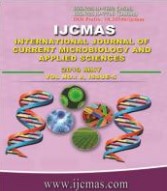


 National Academy of Agricultural Sciences (NAAS)
National Academy of Agricultural Sciences (NAAS)

|
PRINT ISSN : 2319-7692
Online ISSN : 2319-7706 Issues : 12 per year Publisher : Excellent Publishers Email : editorijcmas@gmail.com / submit@ijcmas.com Editor-in-chief: Dr.M.Prakash Index Copernicus ICV 2018: 95.39 NAAS RATING 2020: 5.38 |
A field experiment was conducted on sandy clay soils of Agricultural College Farm, Aswaraopet, Khammam (dt.) to study the performance of kharif legume crops residue management practices and nitrogen levels on the soil physical and microbial characters as influenced by legume residue management practices in legume maize sequence. The experiment was laid out in split- split plot design and the treatments were replicated thrice with three legumes, viz., cowpea, (M1) fieldbean (M2) and greengram (M3) as main plot treatments taken up during the kharif season and two residue management practices viz., residue removal (R0) and residue incorporation (R1) as sub plot treatments. Four nitrogen levels 75 (N1), 150 (N2), 225 (N3) and 300 kg ha-1( N4) as sub- sub plot treatments to maize. The experiment was conducted for two consecutive years. Soil physical microbial properties were analysed to know different parameters. Bulk density of the soil, in general, had decreased over the initial value with the cultivation of all the legumes. The minimum bulk density of 1.31 and 1.30 g cc-1 was obtained with the cowpea during the Ist and the 2nd years, respectively and the maximum bulk density (1.33 and 1.30 g cc-1) for the corresponding period was noticed with greengram. Residue incorporation of all the legumes had shown further decrease in bulk density of the soil over their removal. Improvement in soil microbial population viz., total bacteria, rhizobium, azatobactor, actinomycetes and fungi was observed over the initial population, when legumes were grown in kharif. Among the legumes, maximum number of soil micro flora was found after the harvest of cowpea followed by field bean and greengram. Incorporation of legume crop residues further increased the different micro flora. The kernel yield of maize was significantly high when cowpea was taken as a preceding crop to maize. Residue incorporation has resulted in significant improvement in yield of maize compared to residue removal in all the three kharif legumes during both the years. The Kernal yield of maize was realized with the incorporation of crop residues is 5884 and 6147 kgha-1 during first and second year of investigation respectively.
 |
 |
 |
 |
 |